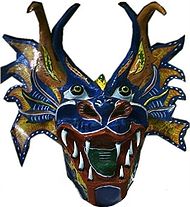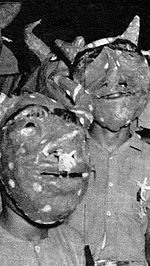- Dancing Devils of Yare
-
The Dancing Devils of Yare (Diablos Danzantes del Yare) is the name of a religious festivity celebrated in San Francisco de Yare, Miranda state, Venezuela, at the Corpus Christi day. The Sociedades del Santísimo (Societies of the Holiest) are in charge of the celebration. Its origins are traced back to the 18th century, being the oldest brotherhood of the American continent.
Every Corpus Christi (nine Thursdays after Holy Thursday), a ritual dance is performed by the so called "Dancing Devils", who wear colorful garments (commonly all red), layers of stripped fabric, masks of grotesque appearance and also accessories like crosses, scapulars, rosaries and other sorts of amulets.
The fraternity of the devils is divided in hierarchical order, represented in their masks.
There are other expressions of this particular festivity named according to the location, such as the Devils of Naiguatá and the Devils of Chuao.
Contents
Procession and dress code
In this folkloric festivity devotion is given to the patron saint Saint Francis of Paola, to the Blessed Sacrament and to Jesus Christ. The celebration starts Wednesday with a wake where fulías (a native music style) are played, décimas (native form of poetry) are recited and rosaries and other prayers are prayed until dawn. The next day the devoted disguised as devils perform dances around the principal square of the town. They also parade through the streets, dressed in their red costumes and their masks, dancing to the rhythm of corríos (octosyllabic musical poems).
Later on, they move towards the front of the church and when mass is ended, the Eucharist is placed at the church's entrance and a sort of fight representation begins between the devils and the guardians. Finally, the devils surrender and kneel in front of the Eucharist to show submission, dancing then to the rhythm of the bamba, a music style that is more reverential. The entire performance represents the victory of Good over Evil. The dancing devils wear a red shirts, trousers and stockings, a mask depicting a devil, and canvas sandals. They carry a cross made out of blessed palm leafs, a rosary, and a medallion with the image of Christ (that can be substituted by another Christian religious image). They also carry in one hand a devil-shaped maraca and in the other a whip.
Role of women
The women of the town go in mass with the "Devils" and follow them throughout the course of the parade, assisting them by providing water and food, taking care of the children, and also, by acting as "Arrieras", who walk in front of the parade clearing the path and providing guidance to the dancers since the devils dance backwards and wearing their sometimes massive masks. They don't dance but in one house where they borrow a mask and dance in front of an altar. All the women participating wear a red skirt and white blouse or t-shirt with sandals of the same color, on their heads they carry a red and white handkerchief, and if they are part of the "Arrieras" carry a long wood stick. Tokens of Christianity as rosaries and images of saints are often added. The Forewoman is the highest authority among the women; she dresses completely in red and doesn't wear a mask.
References
External links
Categories:- Venezuelan culture
- Latin American culture
- Miranda (state)
Wikimedia Foundation. 2010.


